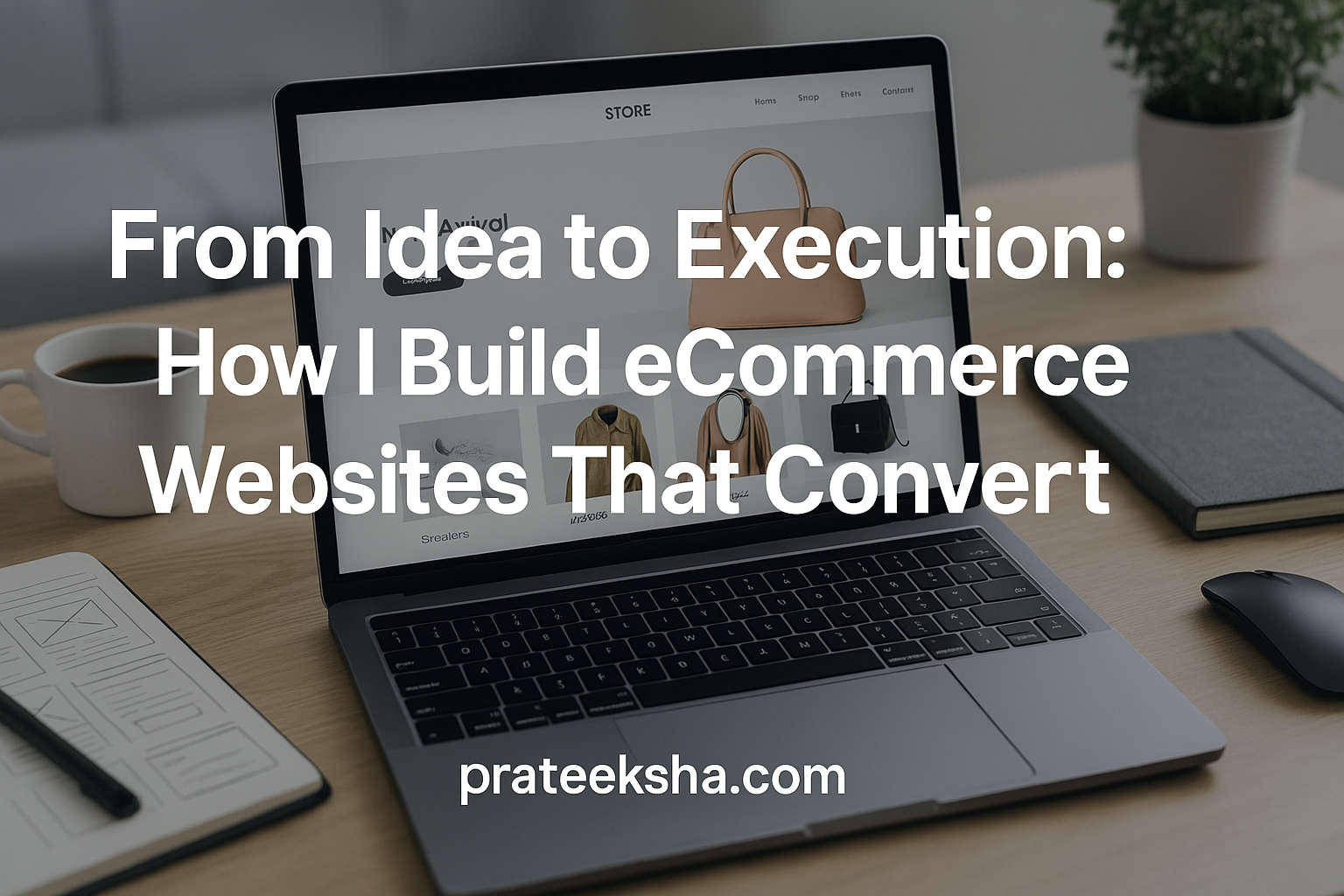From Idea to Execution- How I Build eCommerce Websites That Convert

In today’s digital landscape, building a successful eCommerce website requires more than just an attractive design—it demands a strategic approach that prioritizes user experience, conversion rates, and effective marketing. If you’re a busy business owner eager to transform your vision into a revenue-generating online store, you’re in the right place. Here’s a straightforward guide detailing how I develop eCommerce websites that not only look good but also convert traffic into sales.
Understanding eCommerce Website Design
The foundation of a successful online store starts with effective eCommerce website design. Your website is often the first impression potential customers will have of your brand, so it must reflect professionalism and trustworthiness. Here are key elements of a successful eCommerce website design:
1. Responsive Design
With a substantial amount of online shopping happening via mobile devices, having a responsive design is critical. This means your website should adapt seamlessly to different screen sizes. A responsive layout enhances user experience and can significantly increase conversion rates.
2. Intuitive Navigation
Users should find it easy to locate products or information on your site. Implement a clear menu structure, categorize products effectively, and use search functionality to help users navigate your site smoothly.
3. High-Quality Images and Descriptions
Visual appeal is crucial in eCommerce. Use high-quality images that showcase your products from multiple angles. Pair these visuals with compelling descriptions that highlight features and benefits, guiding customers toward making a purchase.
4. Streamlined Checkout Process
A complicated checkout process can lead to abandoned carts. Ensure your checkout is straightforward and requires minimal steps. By allowing guest checkouts and offering various payment options (credit cards, PayPal, etc.), you can significantly increase conversions.
Website Conversion Strategies
Once your site is live, the next step is to implement website conversion strategies that will turn visitors into paying customers. Here are several tactics I use to enhance conversions:
1. Optimize for Speed
Page load speed is a crucial factor in retaining visitors. Slow-loading pages can deter potential buyers. Utilize tools like Google PageSpeed Insights to analyze your site and make the necessary adjustments to improve load times.
2. Use Clear Calls-to-Action (CTAs)
Your CTAs should be prominent and persuasive. Phrases like “Buy Now,” “Add to Cart,” or “Get Yours Today” can guide users toward taking action. Experiment with colors and placements to see what resonates most with your audience.
3. Implement Exit-Intent Popups
Exit-intent popups are a fantastic way to capture leads or encourage sales from visitors who are about to leave your site. Offering a discount code or a free eBook can entice them to stay and complete their purchase.
4. Leverage Social Proof
Showcasing customer reviews, testimonials, and user-generated content builds trust and credibility. Consider implementing a reviews section on product pages or displaying testimonials in a slider format.
Building Online Stores: The Technical Side
Effective eCommerce websites are not just about the frontend design. The backend development plays an equally vital role in ensuring smooth operation. Here’s what I focus on when building online stores:
1. eCommerce Platform Selection
Choosing the right eCommerce platform is paramount. Platforms like Shopify, WooCommerce, and Magento each have strengths that cater to different business needs. Consider factors such as scalability, ease of use, and budget when making your selection.
2. SEO and Website Development for Sales
A great design means little if your website isn’t optimized for search engines. Implementing SEO best practices can dramatically increase your visibility. This includes keyword optimization, meta descriptions, and optimized URLs. Regularly creating quality content relevant to your industry can also boost organic traffic.
3. Integration with Third-Party Tools
Integrate essential third-party tools for improved functionality. This could include email marketing services like Mailchimp, analytics tools like Google Analytics, and payment processors. These integrations help streamline operations.
Effective eCommerce Tips for Increased Online Sales
Increasing online sales isn’t just about having a beautiful website. It requires strategic planning, ongoing optimization, and a focus on your target audience. Here are effective eCommerce tips for maximizing sales:
1. Utilize Digital Marketing for eCommerce
Develop a robust digital marketing strategy that incorporates social media, email marketing, and content marketing. This multi-channel approach will help you reach more potential customers and nurture existing leads.
2. Retargeting Ads
Leverage retargeting ads to bring back visitors who did not complete a purchase. By showing ads to users who have previously visited your site, you can remind them of what they’re missing and encourage them to return.
3. A/B Testing
Regularly test different elements of your website, from CTAs to product descriptions. A/B testing helps identify what resonates with your audience, allowing you to make data-driven decisions for optimizing conversions.
4. Incorporate Social Media
Today’s consumers often rely on social media for purchasing decisions. Utilize platforms like Instagram and Facebook to promote products and engage with your audience. Social selling is a powerful tool to increase brand awareness and drive sales.
User Experience in eCommerce
User experience (UX) should always be at the forefront of your website's design and functionality. A positive UX can minimize bounce rates and improve customer satisfaction. Here are several strategies to enhance user experience in eCommerce:
1. Fast and Efficient Search Functionality
A robust search feature that includes filters and auto-suggestions helps users quickly find what they’re looking for. This not only enhances user experience but also boosts sales opportunities.
2. Clear Contact Information
Customers should always have easy access to your contact information. Whether through chat, email, or a phone number, being easily reachable fosters trust and reliability.
3. Transparent Shipping and Return Policies
Clearly outline your shipping options and return policies to set the right expectations. Transparency in these areas can alleviate concerns customers may have about purchasing from your site.
Tips for a Successful Online Business
Building an eCommerce website is just the start. To maintain long-term success, you should consider the following tips for running a successful online business:
1. Regularly Analyze Performance Data
Track your website's performance regularly. Utilizing Google Analytics, you can monitor traffic, user behavior, and sales conversions. This data enables you to make informed decisions and tweak your strategies as necessary.
2. Focus on Customer Engagement
Engage with your customers through newsletters, social media, and personalized marketing efforts. Keeping your audience engaged fosters brand loyalty and encourages repeat purchases.
3. Stay Updated on Industry Trends
The eCommerce landscape is constantly evolving. Stay informed about the latest trends and technologies. Participating in industry events or webinars can provide valuable insights into what’s next for eCommerce.
Conclusion
Building a high-performing eCommerce website is a multifaceted endeavor that requires careful planning, effective strategies, and ongoing optimization. By focusing on key areas like website design, user experience, and digital marketing, you can create an online store that not only attracts visitors but also converts them into loyal customers.
Remember, the journey from idea to execution requires patience and perseverance. However, with these strategies in hand, you’re well-equipped to launch and scale a successful online business. Start today and watch your eCommerce vision come to life!
